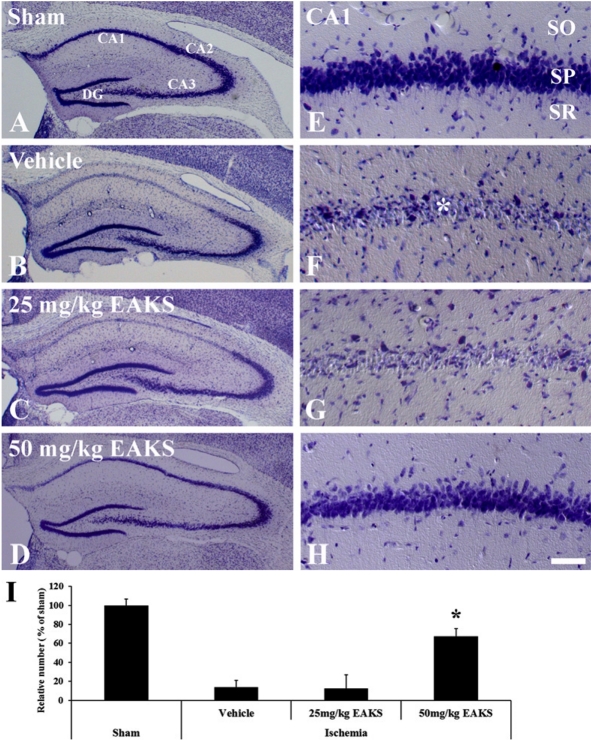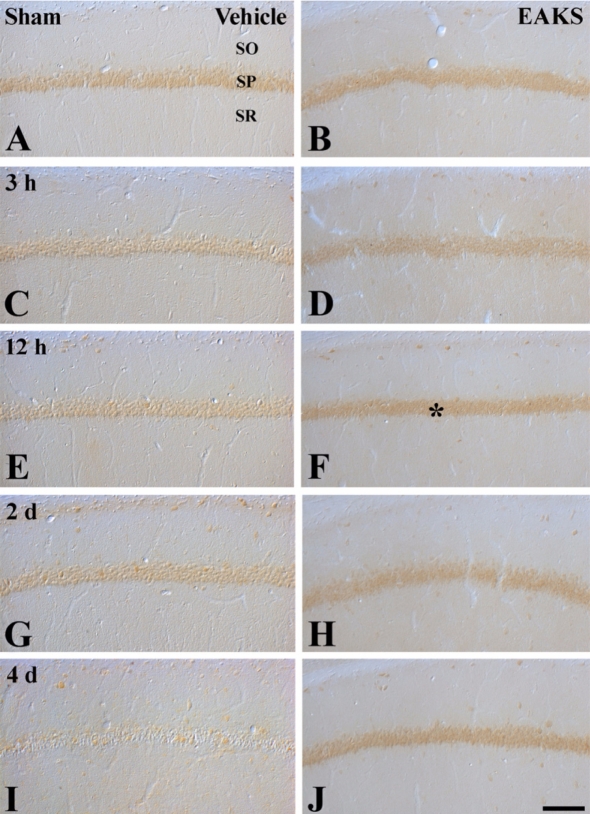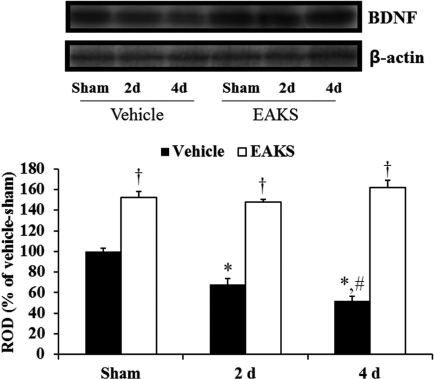Lab Anim Res.
2011 Mar;27(1):67-71. 10.5625/lar.2011.27.1.67.
Neuroprotection of Alpinia katsumadai Seed Extract against Neuronal Damage in the Ischemic Gerbil Hippocampus is Linked to Altered Brain-Derived Neurotrophic Factor
- Affiliations
-
- 1Department of Neurobiology, School of Medicine, Kangwon National University, Chuncheon, Republic of Korea. mhwon@kangwon.ac.kr
- 2Department of Anatomy and Neurobiology, College of Medicine, Hallym University, Chuncheon, Republic of Korea.
- 3Department of Oral Anatomy, College of Dentistry, Gangneung-Wonju National University, Gangneung, Republic of Korea.
- 4Laboratory of Veterinary Pharmacology, College of Veterinary Medicine, Seoul National University, Seoul, Republic of Korea.
- 5Department of Anatomy, College of Veterinary Medicine, Kangwon National University, Chuncheon, Republic of Korea.
- 6Department of Anatomy and Cell Biology, College of Veterinary Medicine, and Research Institute for Veterinary Science, Seoul National University, Seoul, Republic of Korea.
- KMID: 2391862
- DOI: http://doi.org/10.5625/lar.2011.27.1.67
Abstract
- The extract of Alpinia katsumadai, a member of the family Zingiberaceae, shows anti-inflammatory effects and antioxidant activity. We observed the neuroprotective effects of the extract from Alpinia katsumadai seed (EAKS) against ischemic damage in gerbils administered oral EAKS (25, and 50 mg/kg) once a day for 7 days before transient cerebral ischemia. In the 50 mg/kg EAKS-treated ischemia group, about 67% of neurons in the hippocampal CA1 region (CA1) survived after ischemia/reperfusion (I/R) based on cresyl violet staining. We observed that EAKS treatment significantly maintained brain-derived neurotrophic factor (BDNF) immunoreactivity in the ischemic CA1 region after I/R. In addition, protein levels of BDNF in the 50 mg/kg EAKS-treated ischemia group were much higher than those in the vehicle-treated ischemia group after I/R. These findings indicate that repeated supplementation of EAKS protects neurons from ischemic damage, such that BDNF is distinctively maintained in ischemic areas.
Keyword
MeSH Terms
Figure
Reference
-
1. Ahn HC, Yoo KY, Hwang IK, Cho JH, Lee CH, Choi JH, Li H, Cho BR, Kim YM, Won MH. Ischemia-related changes in naive and mutant forms of ubiquitin and neuroprotective effects of ubiquitin in the hippocampus following experimental transient ischemic damage. Exp Neurol. 2009; 220(1):120–132. PMID: 19666022.
Article2. Almeida RD, Manadas BJ, Melo CV, Gomes JR, Mendes CS, Grãos MM, Carvalho RF, Carvalho AP, Duarte CB. Neuroprotection by BDNF against glutamate-induced apoptotic cell death is mediated by ERK and PI3-kinase pathways. Cell Death Differ. 2005; 12(10):1329–1343. PMID: 15905876.
Article3. Choi JH, Yoo KY, Park OK, Lee CH, Won MH, Hwang IK, Ryu SY, Kim YS, Yi JS, Bae YS, Kang IJ. Platycodin D and 2"-O-acetyl-polygalacin D2 isolated from Platycodon grandiflorum protect ischemia/reperfusion injury in the gerbil hippocampus. Brain Res. 2009a; 1279:197–208. PMID: 19433075.4. Choi JK, Kim KM, Kim DK, Yeom MH, Koh JY, Jung SJ, Kim HJ, Oh SH, Kim SY, Lee CH. Topical anti-inflammatory and antipruritic effects of Alpinia katsumadai extracts. J Dermatol Sci. 2009b; 53(1):81–84. PMID: 18771901.5. Chun HS, Kim JM, Choi EH, Chang N. Neuroprotective effects of several Korean medicinal plants traditionally used for stroke remedy. J Med Food. 2008; 11(2):246–251. PMID: 18598165.
Article6. Han BH, Holtzman DM. BDNF protects the neonatal brain from hypoxic-ischemic injury in vivo via the ERK pathway. J Neurosci. 2000; 20(15):5775–5781. PMID: 10908618.7. Hua SZ, Luo JG, Wang XB, Wang JS, Kong LY. Two novel monoterpene-chalcone conjugates isolated from the seeds of Alpinia katsumadai. Bioorg Med Chem Lett. 2009; 19(10):2728–2730. PMID: 19362829.8. Hwang IK, Yoo KY, Kim DS, Jeong YK, Kim JD, Shin HK, Lim SS, Yoo ID, Kang TC, Kim DW, Moon WK, Won MH. Neuroprotective effects of grape seed extract on neuronal injury by inhibiting DNA damage in the gerbil hippocampus after transient forebrain ischemia. Life Sci. 2004; 75(16):1989–2001. PMID: 15306166.
Article9. Kim DH, Li H, Yoo KY, Lee BH, Hwang IK, Won MH. Effects of fluoxetine on ischemic cells and expressions in BDNF and some antioxidants in the gerbil hippocampal CA1 region induced by transient ischemia. Exp Neurol. 2007; 204(2):748–758. PMID: 17328894.
Article10. Kirino T. Cerebral ischemia and neuronal death. No To Hattatsu. 1994; 26(2):130–135. PMID: 8136185.11. Kuroyanagi M, Noro T, Fukushima S, Aiyama R, Ikuta A, Itokawa I, Morita M. Studies of constituents of seeds of Alpinia katsumadai Hayata. Chem Pharm Bull. 1983; 31(5):1544–1550.12. Lee SE, Shin HT, Hwang HJ, Kim JH. Antioxidant activity of extracts from Alpinia katsumadai seed. Phytother Res. 2003; 17(9):1041–1047. PMID: 14595584.13. Leeds P, Leng Y, Chalecka-Franaszek E, Chuang DM. Neurotrophins protect against cytosine arabinoside-induced apoptosis of immature rat cerebellar neurons. Neurochem Int. 2005; 46(1):61–72. PMID: 15567516.
Article14. Miller FD, Kaplan DR. Neurotrophin signalling pathways regulating neuronal apoptosis. Cell Mol Life Sci. 2001; 58(8):1045–1053. PMID: 11529497.
Article15. Nazam Ansari M, Bhandari U, Islam F, Tripathi CD. Evaluation of antioxidant and neuroprotective effect of ethanolic extract of Embelia ribes Burm in focal cerebral ischemia/reperfusion-induced oxidative stress in rats. Fundam Clin Pharmacol. 2008; 22(3):305–314. PMID: 18485149.16. Ploughman M, Windle V, MacLellan CL, White N, Dore JJ, Corbett D. Brain-derived neurotrophic factor contributes to recovery of skilled reaching after focal ischemia in rats. Stroke. 2009; 40(4):1490–1495. PMID: 19164786.
Article17. Saiki Y, Ishikawa Y, Uchida M, Fukushima S. Essential oil from Chinese drug 'caodoukou', the seeds of Alpinia katsumadai. Phytochemistry. 1978; 17:808–809.18. Yang J, Dai Y, Xia YF, Huang WZ, Wang ZT. Alpinia katsumadai Hayata prevents mouse sepsis induced by cecal ligation and puncture through promoting bacterial clearance and downregulating systemic inflammation. Phytother Res. 2009; 23(2):267–273. PMID: 18844287.19. Yang Y, Kinoshita K, Koyama K, Takahashi K, Tai T, Nunoura Y, Watanabe K. Two novel anti-emetic principles of Alpinia katsumadai. J Nat Prod. 1999; 62(12):1672–1674. PMID: 10654416.
- Full Text Links
- Actions
-
Cited
- CITED
-
- Close
- Share
- Similar articles
-
- Effects of Calcitriol on Delayed Neuronal Damage of Hippocampus in Transient Global Ischemia Model of Mature Gerbil
- Protective Effects of Alpinia katsumadai Extract Against Oxidative Stress
- Induction of GDNF and GFRα-1 Following AAV1-Rheb(S16H) Administration in the Hippocampus in vivo
- The Roles of BDNF in the Pathophysiology of Major Depression and in Antidepressant Treatment
- The Meaning of BDNF Level Measured in Blood of Depressed Patients




